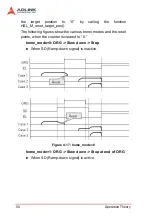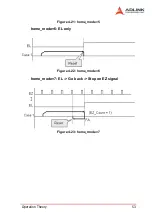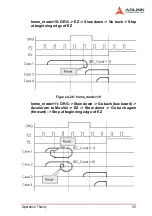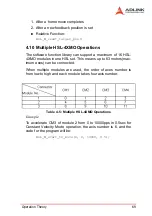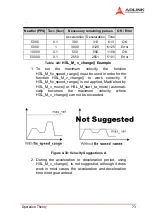
Operation Theory
61
designed to interact with the deviation counter clear signal of the
servomotor driver.
The deviation counter clear signal is inserted in the following 4 sit-
uations:
1. Home return is complete
2. The end-limit switch is active
3. An alarm signal stops the OUT and DIR signals
4. The software operator issues an emergency stop com-
mand
Since the servomotor operates with some delay from the pulse
generated from the HSL-4XMO, it continues to move until the
deviation counter of the driver is zero even if the HSL-4XMO has
stopped outputting pulses because of the ?EL signal or the com-
pletion of home return. The ERC signal allows immediate stopping
of the servomotor by resetting the deviation counter to zero. The
ERC signal is outputted as a one-shot signal. The pulse width is of
time length defined by the function call HSL_M_set_erc(). The
ERC signal will automatically be generated when the ?EL and
ALM signal are turned on and the servomotor is stopped immedi-
ately.
X
Relative Functions:
HSL_M_set_erc()
SVON and RDY
All axes of the HSL-4XMO are equipped with SVON and RDY sig-
nals, which are general purpose output and input channels,
respectively. Usually, the SVON is used to interact with the servo-
motor drivers as a Servo ON command, and RDY to receive the
Servo Ready signal. There are no built-in procedures for SVON
and RDY.
The SVON signal is controlled by the software function
HSL_M_Set_Servo().
RDY pins are dedicated for digital input usage. The status of this
signal can be monitored using the software function
HSL_M_get_io_status().
Summary of Contents for HSL-4XMO
Page 4: ......
Page 16: ...6 Introduction ...
Page 36: ...26 Signal Connections ...
Page 67: ...Operation Theory 57 Home Search Example Home mode 1 Figure 4 29 Home Search Example ...
Page 108: ...98 Motion Creator in LinkMaster ...




